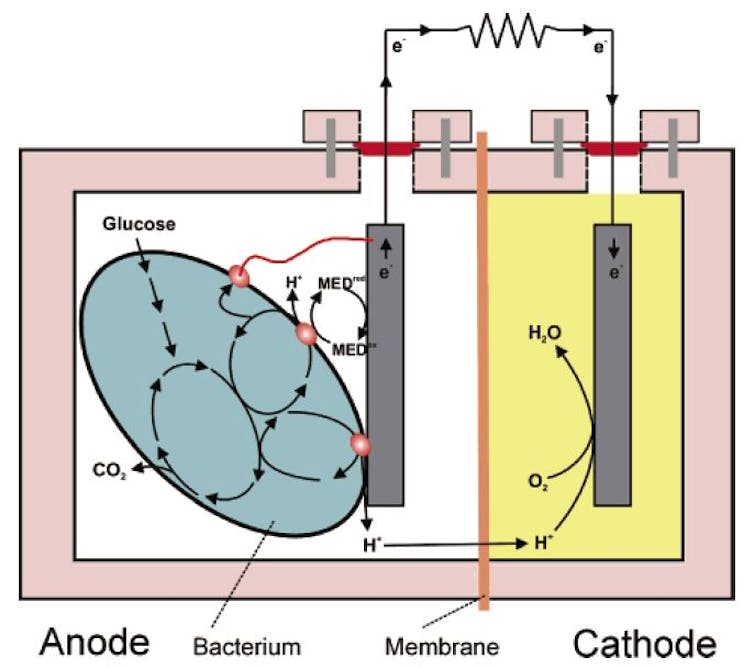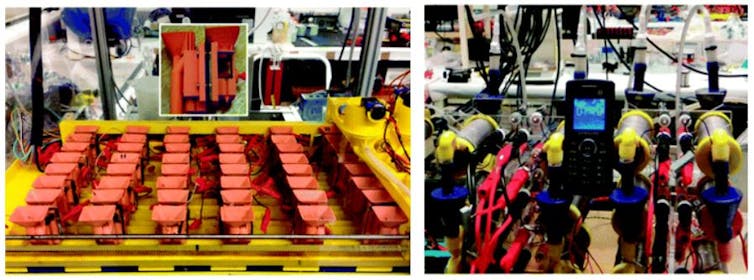We can generate electricity from microorganisms as an alternative to the usual power from water, wind, solar or steam.
Scientists have been studying the ability of microorganisms – the smallest living things on Earth – to produce energy other than for their natural activities for more than a century. This transformation is what scientists call a bioelectrochemical system.
This article shows how microorganisms, such as bacteria, can produce electricity and so potentially be a source of renewable energy.
Electricity from microorganisms
Microbial fuel cell (MFC) is one form of bioelectrochemical systems.
This system generally has one anode chamber (negative electrode) and one cathode chamber (positive electrode). MFC works in a similar way to batteries.
Microorganisms decompose organic or inorganic matters (or substrates) in the anode chamber to produce electrons. These electrons flow from anode to cathode via an external circuit made of conductive materials, such as copper-based wires, to generate electricity.

Renewable energy potential
MFC researchers are focusing on how to produce renewable energy and manage waste on a large and commercial scale in several countries.
Examples range from processing waste from a beer factory in Harbin, China, to lake water processing in Icapuí, Brazil.
In both cases, MFC systems manage to generate electricity without additional power supplies. This will, of course, reduce the bills.
So far, companies known for applying MFC technology at a commercial scale are EcoVolt by Cambrian Innocation, VIVA MFC by MICROrganic Technologies in the US, Prongineer in Canada, and Plant-e in the Netherlands, which integrates MFC with plants in Plant Microbial Fuel Cells (PMFCs).
In addition, NASA (National Aeronautics and Space Administration) has adopted MFC technology since 2006.
In 2011, NASA collaborated with Cambrian Innovation to develop MFC that converts carbon dioxide from the air inside the spaceship into oxygen, water and methane.
Despite these improvements, we still need further research to improve MFC’s efficiency and productivity, especially on a commercial scale.
The right type of microorganism
Deciding on the types of microorganism to generate the energy is an influential factor.
To date, the groups of microorganisms that demonstrate the ability to transfer electrons from their cells to the electrodes – called exoelectrogens – are in particular Geobacter and Shewnella.
Geobacter sulfurreducens KN400 can generate up to 3.9 Watts of electricity per square metre (W/m²) of anode area. Shewanella putrefaciens produces up to 4.4 W/m².
For its spaceship, NASA generates energy from Shewanella oneidensis bacteria.
Other microorganisms such as Rhodopseudomonas palustris DX1, Candida melibiosica, Saccharomyces cerevisiae and even Escherichia coli DH5α also demonstrate exoelectrogenic capabilities.
Research by Krishna Katuri, of the National University of Ireland Galway, and his colleagues from the King Abdullah University of Science and Technology, Saudi Arabia, found a new exoelectrogenic microorganism, Desulfuromonas acetexigens.
Exoelectrogens can be obtained from various environments, such as waste water, compost, manure, dirt, river or lake sediments, swamps and marine ecosystems.
For example, researchers from University of Buenos Aires found Dietzia sp. RNV-4 in river sediment from the Río de la Plata in Argentina.
Potential for Indonesia
Indonesia is a nation with one of the world’s highest levels of biodiversity, including microorganisms.
Unfortunately, only 10% of microorganisms from Indonesia have been identified; their full potential remains untapped.
With better collaboration and co-operation between academics, researchers and industries, microorganisms could be managed as a renewable energy source for Indonesia.

Recently, bioelectrochemical research has started in Indonesia, such as water waste processing of a tofu factory, food waste processing, waste water processing of the tapioca industry, and PMFC to generate electricity from rice fields in West Kalimantan. However, these studies have yet to be reproduced on a larger scale.
From what we have seen in the studies and applications of microorganisms as a source of alternative energy in other countries, Indonesia should be able to develop their potential.
This development will, of course, require support and collaboration from all stakeholders – academics, researchers, industries and governments.
Once it is successfully developed, this technology would be able to solve the country’s electricity supply problem, leaving fossil fuels behind.
Ignatius Raditya Nugraha translated the article from Bahasa Indonesia.


